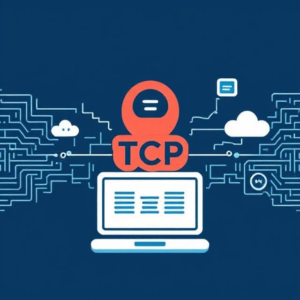When devices like computers, smartphones, or any connected gadgets communicate over a network (such as the internet), they follow a set of rules to ensure they understand each other. These rules are called protocols. You can think of protocols as a common language or handshake between devices that ensures data is sent, received, and understood properly. TCP/IP is one of the key communication protocols that drives the internet, enabling devices to interact and share information seamlessly.
Two crucial protocols used for communication on the internet are TCP (Transmission Control Protocol) and TCP/IP (Transmission Control Protocol/Internet Protocol).

What is TCP (Transmission Control Protocol)?
TCP is a protocol designed to ensure that data is sent reliably and accurately from one device to another. It acts like a postal service for the internet, guaranteeing that the data you send (like a message or file) reaches its destination in the correct order, without any errors.
Here’s how it works:
- Breaking down the data: When you send a large piece of data, such as a video or webpage, TCP splits it into smaller packets.
- Sending the packets: These packets are sent across the internet to the intended device (for example, a website server or your friend’s phone).
- Checking if everything arrived: Once the packets reach their destination, the receiving device checks if all packets were received correctly. If any packets are missing or damaged, the device requests them to be sent again.
- Putting it all together: Once all the packets arrive safely, TCP reassembles them in the correct order, ensuring that the original data is intact and usable.
Why is TCP Important?
TCP ensures reliable, error-free communication. Without TCP, your data might arrive incomplete, out of order, or not at all, which could lead to problems when accessing websites, sending emails, or streaming videos.
What is TCP/IP (Transmission Control Protocol / Internet Protocol)?
TCP/IP is a collection of protocols that work together to ensure proper data transmission across the internet. It includes TCP and another essential protocol called IP (Internet Protocol).
TCP/IP = TCP + IP
- TCP (Transmission Control Protocol): As mentioned earlier, TCP guarantees data delivery with no errors, in the right order.
- IP (Internet Protocol): IP takes care of addressing and routing data. It ensures that the data packets reach the right destination by using unique IP addresses. Think of IP like an address on an envelope. Just as a letter needs the correct address to reach its recipient, IP uses addresses (like 192.168.1.1 or 200.100.50.25) to guide data to its proper destination on the internet.
How TCP/IP Works Together
Here’s an example of how TCP/IP works in action:
- You want to visit a website, like example.com.
- IP helps locate the address of the website’s server (where the site is hosted).
- TCP ensures the website data (such as the content of the page) is sent to you in small, reliable packets, in the correct order.
- Without TCP/IP, devices wouldn’t know how to send data to each other, and the internet wouldn’t function properly.
Why is TCP/IP Important?
TCP/IP is the backbone of the internet. It enables devices across the globe to communicate with one another, regardless of their type or location. Whether you’re sending an email or browsing the web, TCP/IP makes it all happen.
Summary:
- TCP: Ensures that data packets are delivered reliably, checks for errors, and ensures they’re in the correct order.
- IP: Handles addressing and routing of data, ensuring it reaches the correct destination.
Tags: 2G, 3G, 4G, 5G, analog signals, base stations, capacity, cell towers, cells, cellular network, cellular network analysis, Communication Network, connected devices, core network, coverage, data routing, Data transfer, digital signals, frequency bands, gaming over mobile, generations of cellular networks, handover process, high-speed data, internet access, internet access on-the-go, low latency, mobile apps, mobile broadband, mobile communication, mobile connectivity, Mobile devices, mobile internet, mobile network evolution, mobile phones, mobile signal., mobile technology, network architecture, network performance, network reliability, self-driving cars, signal strength, Smart Cities, smartphone network, SMS, speed test, streaming services., Telecommunications, video calling, virtual reality, voice calls, web browsing, wireless communication, wireless devices, wireless infrastructure


